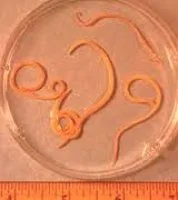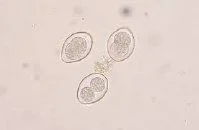Deworming & Fecal Check Gastrointestinal Parasites… a New Look at a Common Problem
In order to ensure the health and well being of our pets, stool examinations for parasite eggs have been part of the veterinary routine for decades. Although stool examinations have become routine, a new procedure has recently been presented that has drastically improved the quality of the results.
Depending on the parasite involved, this new procedure can dramatically influence the quality of the results. Previous methods for hookworms only revealed half the number of parasites as the new method. For roundworms the new method reveals about 100 times more parasites, for whipworms we can now detect infections where the parasite remained undetected before. Detecting the actual parasite burden of our pets is important to the pet’s health, but to protect human health as well. Undetected infection can lead to animal and human illness.
Zoonosis (zo-e-nos-sis) = any disease that can be passed from animals to human.
Although all people are at risk for developing zoonotic infections certain groups of people may be at greater risk; children, elderly, people with immune compromise disorders (diabetes, HIV, organ transplant recipients or people undergoing chemotherapy), people who work with animals at shelters, veterinary hospitals or in other animal related occupations. In the case of intestinal parasites, transmission occurs through accidental oral ingestion of parasite eggs, from accidental ingestion of an infected flea or by penetration of the skin by parasite larvas (hookworms only).
You may not even recognize any illness or see obvious symptoms in your pet until it is too late. Parasite eggs are shed by animals, even those that appear to be well and energetic. Most intestinal parasites can multiply at an alarming rate, so even a single intestinal worm can become a fast-growing problem.
Contaminated pet droppings can carry infective eggs, the source of most pet-to-human infections. Follow these steps to help protect your pet and family:
- Have your pet examined regularly by your veterinarian, who will recommend ascreening test for parasites to be performed twice a year or more often, depending on your pet's lifestyle and risk factors.
- Deworm your pet on a regular schedule recommended by your veterinarian. This removes intestinal parasites and prevents further contamination of the environment.
- Practice good hygiene. Wash hands regularly, especially after handling pets or cleaning up pet waste.
- Remove pet droppings from your yard at least every 2-3 times a week - daily is best.
- Wash all fruit and vegetables thoroughly before eating.
- Keep pets flea-free. Ingestion of infected fleas can transmit tapeworms to animals and people.
- Do not allow children to go barefoot or sit or lie on playgrounds where they may be exposed to animal stools.
- Clean cat litter boxes daily and wash hands afterward.
- Do not drink water from streams or other sources that may be contaminated with animal feces.
- Keep pets clean.
Facts about Intestinal Parasites:
- Zoonotic parasites are transmitted primarily from a contaminated environment, not from normal contact with your pet.
- Parasite eggs cannot be seen by the naked eye even though they may be present in the feces of an infected animal.
- One female roundworm can lay up to 100,000 eggs in a day, and one female hookworm can produce up to 20,000 eggs in a day.
- In just one week, two puppies infected with roundworms can shed more than 20 million eggs and contaminate a 2,800-square-foot backyard.
Roundworms (ascarids) / Toxacaria (dog and cat roundworm):
Roundworms look like a piece of spaghetti with more tapered ends, and may be found in either stool or vomitus. Roundworms are a common intestinal parasite in cats and dogs nationwide. National studies have found that between 90-100% of puppies/kittens less than 3 months of age and up to 20% of adult animals not regularly treated for worms carry this infection. One adult roundworm can produce 100,000 eggs per day. Heavily infected animals can shed millions of eggs per day in their stool. Puppies and kittens have a high incidence of infection because they acquire the infections from their mother either prenatally through the placenta or soon after birth through larva present in the mother’s milk. Infected puppies then shed large numbers of eggs in their stool thus making the nursing mother very susceptible to reinfection – thus continuing the cycle.
Roundworm Disease in Animals:
On infection, the larva not only affects gastrointestinal tissue, but often migrates into other tissues of the body where they “rest” and lie dormant for periods of time up to years. When the animal is stressed such as during a pregnancy, the larva awakens and matures and become infective again. Eggs shed in the stool of infected animals contaminate the environment by getting into the soil where they can survive for long periods of time and serve as a route for infection to any animal that walks or plays in the soil. Infected animals may have a “pot bellied” appearance and no other signs. Others commonly have soft stool, diarrhea, or vomiting. Severe cases of worms can result in malnutrition, dehydration, and intestinal obstructions or twists which may lead death.
Roundworm Disease in People:
Roundworm larvae are ingested by a person due to inadequate hand washing, handling soil contaminated with animal feces, or even by “puppy kisses”. Most human infection goes undetected, however, in some people the larvae migrate through the tissues to the eye or other organs. When the larva migrates into the eye it destroys the tissue which can lead to partial or total blindness. Migration through other tissue in the body may cause nausea, fever, edema and even seizures.
Baylisascaris (raccoon roundworm):
The raccoon roundworm deserves mention because it has been shown to cause infection in other mammals including dogs and humans. This larva is found in soil (yards, gardens, and sandboxes).
Infection of this larva can cause asymptomatic disease as well as severe neurologic disease (due to migration through the brain), seizures and death. A common question asked concerns the frequent recurrence of roundworm infestations. Multiple treatments are commonly required because of the variable maturation rate of the worms. Only adults in the intestine are removed by the medication. Other worms still in the larval stages are migrating in other body tissues and are not killed by dewormers.
Hookworms (ancylostoma):
Hookworms are very common throughout the United States and the world. Approximately 20% of all pets are believed to carry the infection. The larvae are commonly found in damp, sandy soil, including shady areas under bushes, crawl spaces, under porches, sandboxes, and beaches. Infection can result from soil contamination and from mother to newborn via the milk. They are difficult to see with the naked eye due to their size, color and fragility. Hookworms attach themselves to the wall of the intestine and cut a hole in it so that bleeding occurs. The parasites then suck the blood for their nutrition. A heavy infestation in small puppies can cause death from blood loss. This parasite is much more common in dogs than cats.
Hookworm Disease in Animals:
Hookworm infection in animals varies in severity from asymptomatic infection to severe anemia and even death. All age groups can be infected and have severe or fatal disease. Young animals are, however, at the greatest risk. Animals infected in the first days of life with as few as 50-100 worms may result in fatality. Puppies and kittens usually look healthy the first week but soon deteriorate, become pale, have dark or bloody diarrhea and often die by the end of the second week. Hookworms are spread to your pet in several ways. They can be spread to pups/kittens just after birth through the colostrum (first milk) from their mothers. This parasite can also be transmitted to your pet if they eat grass that contains the larvae. Just walking in damp grass or sand if the larvae are present can permit them to be present on the skin and then penetrate and cause an infestation. Hookworms can be very tough to eradicate.
Hookworm Disease in People:
Infected larva from the soil can penetrate and migrate in the skin of humans. This causes a condition called cutaneous larva migrans of “creeping eruption”. Some larva may also enter the gastrointestinal tissue and create an intestinal disease called eosinophilic enteritis.
Whipworms
Whipworms are parasites that live in the cecum, an organ at the junction of the small and large intestines. They cause an irritation and inflammation of the cecum and large bowel with resultant diarrhea (sometimes bloody) and weight loss. These worms do not lay as many eggs as the others do, and therefore can escape detection more easily. These eggs are quite resistant and may require housing the pet in a different area for a time if there is a large number of eggs in a small area (where a dog has been tied or kenneled).
Tapeworm Infection
The flat worms you may see in your pet's stool are pieces of a tapeworm. The actual tapeworm can be up to 3 feet long and attach to the interior of the wall of the intestine. Even though they do attach themselves to the intestine, they do not suck blood from the wall of the intestine, instead they just remain in the intestine and absorb their nutrients from the food your pet has eaten and digested for themselves, and use it for their own. Their presence in the GI tract causes no pain, but it takes more food to keep your pet in good condition. This can result in weight loss, loss of appetite, vomiting or diarrhea. The little pieces that you sometimes see which look like rice when they are dried, are flatter than roundworms. The tapeworm is made up of segments which contain the eggs making it easy to miss in a routine stool check because the eggs are not mixed in with the stool.
Tapeworms differ greatly from the other worms that dogs and cats can get in that they require an intermediate host for transmission. In other words, a portion of the life cycle must take place in another animal. There are two tapeworms that are common in this area. The most common is Diplidium caninum, the flea tapeworm, and since it is the most common, when you see evidence of a tapeworm infestation, look for fleas. They are passed to the pet by licking their coats and ingesting infested fleas from themselves. The other but less common tapeworm is Taenia sp. The intermediate host for this is the rabbit and occasionally rats or mice. This is a tapeworm of the hunter that eats its quarry.
Humans can be infected by one of the tapeworm species. Infection can be from direct contact with infected pets or from infected soil in the environment. Infection results in cysts in the liver, lungs or other tissues of the body. Although this species has only been documented in the western part of the country, recent cases as far east as Ohio have been reported.
Coccidia
Coccidia are one celled animals (protozoans) that reproduce inside the cells that line the intestine. They are found everywhere dogs have been and it is necessary that puppies and kittens develop immunity against them in order to have no possibility of future problems with them. The difficulty comes when young pups and kittens come in contact with large numbers of them before immunity is formed. The method of treatment is to reduce the numbers of coccidia in the intestinal tract to numbers the pets can handle and allow them to develop immunity. So, in the absence of diarrhea, finding these in stool samples is not considered a problem for that patient unless there is evidence of clinical disease in littermates. There are no medications that will kill coccidia, only the pet's immune system can do that. But we can give medicines called “coccidiostats” which can inhibit coccidial reproduction. Once the numbers stop expanding, it is easier for the pet's immune system to “catch up” and wipe the infection out. This also means that the time it takes to clear the infection depends on how many coccidia organisms there are to start with and how strong the pet's immune system is. A typical treatment course lasts about 1-2 weeks but it is important to realize that the medication should be given until the diarrhea resolves plus an extra couple of days. Medications should be given for at least 5 days, sometimes as long as a month is needed.
Giardia
Giardia is another protozoan parasite that is becoming more common in this area. It is spread through drinking infected water and causes profuse watery, sometimes bloody diarrhea. This parasite can be difficult to diagnose because of their fragility and small size. There is a test that can be performed in our office that is much more sensitive that can be used to establish a diagnosis.
Deworming Guidelines for Dogs
Puppies & Kittens –
- Every 2 weeks until 3 months of age
- Once a month from 3-6 months of age
Adult Dogs & Cats -
- Treat regularly, considering potential exposure to parasites and prepatent periods
- Strongly recommend doing a fecal yearly
Lactating Dogs & Cats -
- Should be treated concurrently with puppies
Newly Acquired Puppies/Dogs & Kittens/Cats -
* Immediately, then repeat after 2 weeks, then follow guidelines above



